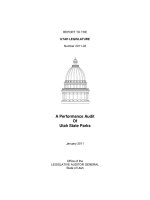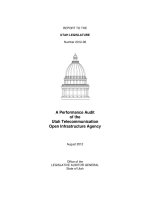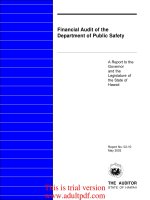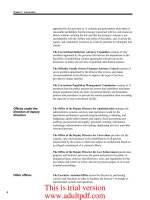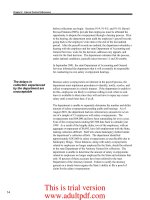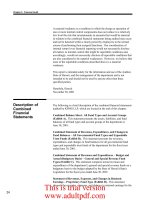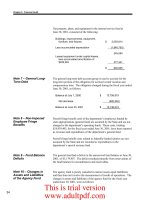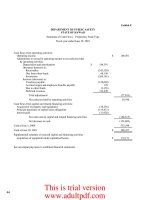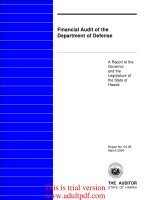REPORT TO THE UTAH LEGISLATURE Number 2011-03: A Performance Audit Of Utah State Parks pptx
Bạn đang xem bản rút gọn của tài liệu. Xem và tải ngay bản đầy đủ của tài liệu tại đây (1.32 MB, 86 trang )
REPORT TO THE
UTAH LEGISLATURE
Number 2011-03
A Performance Audit
Of
Utah State Parks
January 2011
Office of the
LEGISLATIVE AUDITOR GENERAL
State of Utah
Office of the Legislative Auditor General
STATE OF UTAH
315 HOUSE BUILDING • PO BOX 145315 • SALT LAKE CITY, UT 84114-5315
(801) 538-1033 • FAX (801) 538-1063
JOHN M. SCHAFF, CIA
AUDITOR GENERAL
Audit Subcommittee of the Legislative Management Committee
President Michael G. Waddoups, Co–Chair • Speaker Rebecca D. Lockhart, Co–Chair
Senator Ross I. Romero • Representative David Litvack
January 18, 2011
TO: THE UTAH STATE LEGISLATURE
Transmitted herewith is our report, A Performance Audit of Utah State Parks
(Report #2011-03). A digest is found on the blue pages located at the front of the
report. The objectives and scope of the audit are explained in the Introduction.
We will be happy to meet with appropriate legislative committees, individual
legislators, and other state officials to discuss any item contained in the report in
order to facilitate the implementation of the recommendations.
Sincerely,
John M. Schaff, CIA
Auditor General
JMS/lm
Office of the Utah Legislative Auditor General
i
Digest of
A Performance Audit of
Utah State Parks
With state park systems across the nation under pressure to reduce use
of taxpayer funds, this audit was requested by the Natural Resources
Appropriations Subcommittee to identify strategies for the Utah state
park system to be more self sufficient and reduce its reliance on the
General Fund. The Utah Division of Parks and Recreation (division)
oversees 43 state parks and has responsibility for patrolling thousands
of miles of off-highway-vehicle (OHV) and snowmobiling trails, as
well as the state’s waterways.
Division Needs to Develop a More Business Focused Operation
to Improve Park System Efficiency. This chapter describes a
number of business practices and cost cutting strategies that should
help the division reduce its reliance on the General Fund. The General
Fund represents nearly one third of the division’s revenues which are
used mainly to cover the operating deficits at state parks. We
recommend that the Legislature consider gradually reducing the
division’s General Fund appropriation over the next few years. The
division should also begin to manage parks as independent business
units, adopt better accounting tools for managing the park system and
consider return on investment before advancing capital projects.
Decreasing Operating Expenses by Reducing the Cost of Park
Staff Is Achievable. Staffing expenses represent 60% of the division’s
total costs and the division will need to evaluate the necessity of some
positions if it is to become less reliant on the General Fund. This
chapter identifies four strategies to achieve budget reductions and
improve park efficiency through staffing modifications. First, the
division relies on full-time staff at parks even though visitation is
highly seasonal. The division should use a lower-cost staffing
methodology that emphasizes a reduction of full-time employees and
supplements peak demands with more seasonal staff. Second,
additional savings can be created by reducing state and regional
overhead costs. Third, downsizing law enforcement at parks where
there is less need for police power would reduce additional
unnecessary costs. Finally, consolidating park manager positions will
enable one manager to oversee multiple parks. Phasing in a mix of
Chapter II:
Improved
Business
Practices
Should Reduce
Reliance on
General Fund
Chapter III:
Management of
Staff Resources
Must Improve
Chapter I:
Introduction
A Performance Audit of Utah State Parks (January 2011)
ii
these strategies will move the division toward a more efficient park
system that is less reliant on the General Fund.
Parks Need to Modify Operations to Align More Closely to
Public Demand. We identified three strategies to achieve reductions
through operational modifications to parks. However, even after all
cost cutting measures are deployed the revenues generated at some
parks may not meet expenditures. Scaling back seasonal operations is
the first area we address. Under this arrangement parks could suspend
services, programs, and significantly reduce staff presence at parks to
reduce operating expenses during the winter months when visitation is
low. Next, the division should evaluate which parks could generate
additional savings by modifying hours of operation and days of the
week parks are open, similar to efforts already made at heritage parks.
Despite the effectiveness of these strategies, some parks suffer from
persistently low visitation and have large operating deficits. Unless a
strategy can be developed to reduce these deficits, the Legislature
could consider permanently closing some of these parks or transferring
operations to a local municipality.
Park Privatization Efforts Have Been Limited, But Are Feasible
with Careful Planning. Privatization of state parks as an operational
model is feasible, but it is relatively untried. It has primarily been
implemented under unique circumstances. While other states provide
few examples of privatized park operations, the United States Forest
Service (USFS) has had success with privatization of some operations.
If the Legislature decides to increase the level of privatization in the
state park system, it would require careful planning and oversight. We
recommend that if the Legislature decides to pursue privatization of
state parks, a pilot program be implemented first to gauge success.
Increased privatization of state parks could be helpful in making the
state park system more efficient and less reliant on state General
Funds.
It is essential for the division to address recommendations made
throughout this report in order to become more efficient and fully
understand the costs and benefits associated with each park. For
privatization to be appealing to the state, the key is whether total
expenses shifted to private partners are greater than privatized
revenues to allow for savings while maintaining a quality operation.
Chapter IV:
Some Parks
Should Reduce
Services While
Others May
Need to Close
Chapter V:
Legislature
Could Consider
Privatization of
Some Utah State
Parks
REPORT TO THE
UTAH LEGISLATURE
Report No. 2011-03
A Performance Audit
Of Utah State Parks
January 2011
Audit Performed By:
Audit Manager Rick Coleman
Audit Supervisors James Behunin
Brian Dean
Audit Staff Christopher Otto
August Lehman
Candace Ware
Sumner Newman, Contract Auditor
Office of the Utah Legislative Auditor General
Table of Contents
Page
Digest i
Chapter I
Introduction 1
Utah’s Division of Parks and Recreation Fills Many Roles 1
Division Relies on General Funds to Support Park Operations 2
State Park Systems Nationwide Are Under Pressure 6
Audit Scope and Objectives 7
Chapter II
Improved Business Practices Should Reduce Reliance on General Fund 9
Legislature Should Consider Reducing the Division’s General Funds 9
Park System Should Employ Good Business Practices 12
Recommendations 18
Chapter III
Management of Staff Resources Must Improve 19
Less Reliance on Full-Time Employees Can Reduce Park Costs 19
Division Should Consider Reducing Overhead and Other Costs 25
Downsizing Law Enforcement Would Reduce Unnecessary Costs 27
Division Could Consolidate Park Management 31
Recommendations 33
A Performance Audit of the Division of Parks and Recreation (January 2011)
Chapter IV
Some Parks Should Reduce Services, While Others May Need to Close 35
Modifying Operations Can Reduce Expenses 35
Legislature Should Consider Closing Some Parks 38
Recommendations 41
Chapter V
Legislature Could Consider Privatization of Some Utah State Parks 43
Park Privatization Efforts Have Been Limited,
But Is Feasible with Careful Planning 43
Utah State Parks Could Be Privatized 48
Recommendations 57
Appendices 59
Agency Response 68
Office of the Utah Legislative Auditor General
1
Chapter I
Introduction
State parks agencies in most western states are under pressure to
reduce their dependence on taxpayer support. State governments are
facing tough financial conditions and finding it difficult to pay for
basic services such as education, human services, and corrections. For
this reason, some states are beginning to question the practice of
subsidizing recreational activities such as camping, golf, and water
sports. Many states surrounding Utah have asked their state parks and
recreation agencies to reduce their budgets and find sources of support
other than General Fund appropriations. In response, some states
have reduced hours of park operation and some have reduced park
staff. A few states have even closed some parks.
The Legislature asked the Legislative Auditor General to examine
the Division of Parks and Recreation (division) to identify ways to
reduce the division’s reliance on General Fund support. This report
explores several strategies for improving efficiency and reducing the
cost of state parks. We also examined the opportunities and potential
benefits of privatizing state parks.
Utah’s Division of Parks and
Recreation Fills Many Roles
The Utah Division of Parks and Recreation is a division of the
Department of Natural Resources with a broadly stated mission:
To enhance the quality of life by preserving and providing
natural, cultural, and recreational resources for the enjoyment,
education, and inspiration of this and future generations.
Utah’s state parks system offers many opportunities for recreation, and
preserves scenic areas and historic landmarks. The facilities operated
by the division include museums, marinas, golf courses, campgrounds,
and historic buildings. As shown in Figure 1.1, Utah’s 43 state parks
can be broadly classified in three categories: recreational, historic, and
scenic. Appendix A includes a map showing the location of each state
Utah’s 43 state parks
include recreational,
historic, and scenic
parks.
A Performance Audit of the Division of Parks and Recreation (January 2011)
2
park. The division also patrols and maintains some waterways, trails,
and other resources that are located outside of its parks.
Figure 1.1 Division of Parks and Recreation Manages a Variety of
Recreational Facilities. Utah’s state parks are classified as heritage,
scenic, or recreation parks. Four state-run golf courses are within parks.
The division also provides support at other recreation areas.
Heritage Parks (8)
Recreation Parks (28)
Anasazi
Bear Lake
Millsite
Camp Floyd/Stagecoach Inn
Coral Pink Sand Dunes
Otter Creek
Edge of the Cedars
Deer Creek
Palisade
Fremont Indian
East Canyon
Piute
Frontier Homestead
Escalante Petrified Forest
Quail Creek
Territorial Statehouse
Flight Park
Red Fleet
This Is The Place
Great Salt Lake Marina
Rockport
Utah Field House Museum
Green River
Sand Hollow
Scenic Parks (7)
Gunlock
Scofield
Antelope Island
Historic Union Pacific Rail Trail
Starvation
Dead Horse Point
Huntington
Steinaker
Goblin Valley
Hyrum
Utah Lake
Goosenecks
Jordan River OHV
Willard Bay
Kodachrome Basin
Jordanelle
Yuba
Snow Canyon
Wasatch Mountain
State-Run Golf Courses (4)
Other Recreation Areas (4)
Green River
Flaming Gorge
Palisade
Gunnison Bend
Soldier Hollow
Lake Powell
Wasatch Mountain
Monte Cristo
In addition to its 43 state parks and four golf courses within some
parks, the Division of Parks and Recreation is responsible for
recreational areas not directly associated with a state park. For
example, the division reports it patrols approximately 50,000 miles of
off-highway-vehicle (OHV) trails and grooms some 1,200 miles of
snowmobile trails. The division also patrols major waterways such as
Lake Powell and Flaming Gorge. Of the division’s 220 full-time staff,
75 are certified law enforcement officers.
Division Relies on General Funds
To Support Park Operations
The division’s financial support comes through appropriations
from two budget line items: an operations line item and a capital line
The Division of Parks
and Recreation is also
responsible for
maintaining and
patrolling off-highway-
vehicle trails.
Office of the Utah Legislative Auditor General
3
item. For fiscal year 2010, the division spent the following amounts
for the two line items:
Operations Line Item: $ 30,103,596
Capital Line Item: 3,755,051
Although we touch lightly on the division’s spending on capital
projects, the main focus of this report is on maximizing the efficiency
of the division’s operations budget. The operations budget is also
much larger than the capital budget and therefore received greater
consideration during the audit process.
General Funds Represent Nearly
One-Third of Division Revenues
General Fund appropriations represent 31 percent of the division’s
revenues. In fiscal year 2010, the division relied on $9.2 million in
General Funds to pay for 31 percent of its operating costs. As seen in
Figure 1.2, the remaining revenues are comprised of user-based fees
and a small amount of federal funds.
Figure 1.2 Users Pay Nearly Two-Thirds of Division Costs. A
majority of the division’s costs are paid by users in the form of direct park
revenues, such as gate fees, as well as registration fees for boats and off-
road vehicles. General tax funds pay for 31 percent of division costs.
Direct Park
Revenues
40%
Boating
Registration
and Gas Tax
OHV
Registration
and Gas Tax
Federal and
Other Grants
5%
General Fund
31%
11%
13%
The focus of this
report is on the
division’s $30 million
operations budget.
Park users pay for 64
percent of the cost of
operating state parks.
Taxpayers contribute
another 31 percent.
The remaining 5
percent comes from
grants.
A Performance Audit of the Division of Parks and Recreation (January 2011)
4
The division’s revenues include several categories of user-based
fees. Direct park revenues consist of the fees paid by campers and day
use visitors of the state parks as well as green fees at the golf courses,
revenue from equipment rentals, and retail sales at gift shops. The
division also receives registration fees paid by the owners of boats and
OHVs and a small portion of the state gas tax to support the division’s
efforts in those two areas. Finally, the division has several restricted
accounts that contain federal grants and revenues from user groups
which make up five percent of revenues.
General Funds Are Mainly Used to Pay for Operating Deficits
at Utah State Parks. In 1957, the Legislature authorized the Utah
State Parks Commission to develop parks and recreation areas and to
preserve and protect historic sites and scenic treasures. The division
reports that the original intent of the Legislature was not for parks to
be 100 percent self sustaining. Instead, the division has operated
under a funding model using a mix of user fees and taxes.
Over the years, the Legislature has increased the number of state
parks to 43 and provided tax funds to help support the parks, each of
which has a unique history. For example, the Palisade State Park was
once a private resort known as Funk’s Lake in the 1870s. In 1959, the
Utah State Parks and Recreation Commission identified the area as a
potential state park to “aid in the local economy while providing
recreation for residents and visitors.” In 1964, Sanpete County
donated 62 acres of lakeshore to the state. In the 1970s, the county
used a federal grant to construct a golf course and, in 1986, the
division added the golf course to Palisade State Park. The division
reports that until recently, there has been no expectation that state
parks and golf courses would cover their operating costs with user
fees. However, the division is now working to become more self-
sufficient.
During fiscal year 2010, the state’s park system required $6.9
million in General Funds to cover park operating expenses not covered
by user fees. That same year the division spent another $2.3 million in
General Funds on costs not directly associated with park operations.
These costs included the division’s annual commitment to This Is The
Place Foundation and the payments on the debt for two state golf
courses. Figure 1.3 summarizes how the division spent its General
Funds in fiscal year 2010.
Office of the Utah Legislative Auditor General
5
Figure 1.3 The Division Used General Funds Primarily to Support
State Parks. For fiscal year 2010, the division spent $9.2 million in
General Funds. The list below describes how those funds were used.
Appendix B.1 includes additional detail for the amounts shown here.
Support of State Park Operations
Heritage Parks
$2,186,800
Recreation Parks
2,084,400
Scenic Parks
1,208,100
Golf Courses
752,300
Other Park Units*
681,100
Subtotal:
$6,912,700
Other Uses of General Funds
This Is The Place Foundation
$800,000
Soldier Hollow Golf Course Bond Payment
1,100,100
Wasatch Mountain Golf Course Bond Payment
371,400
Subtotal:
$2,271,500
Total:
$9,184,200
*Includes Lake Powell, Monte Cristo, Antelope Island bison, Flaming Gorge, Gunnison Bend.
Of the nearly $9.2 million of General Funds spent by the division
in fiscal year 2010, about $6.9 million supported state park operations
managed by the division. That amount was needed in addition to fees
already paid by the users of state parks to pay the operating costs. If
the state parks were treated as independent business units, the $6.9
million would represent the total loss incurred by the state parks.
In this report, the full costs of state parks are usually reported. The
full costs include the direct costs of operating a park plus the allocated
overhead costs. There are two exceptions, however. We do not
report the cost of two bond payments for the Soldier Hollow and
Wasatch Mountain golf courses as part of the operating expenses. We
view those bond payments as a capital cost rather than an operating
cost.
General Funds Were Used to Pay Park Costs While Park
Revenues Were Lapsed to the Restricted Accounts. The $9.2
million in General Funds used represents the actual amount needed to
operate state parks. The division was actually appropriated
$10,388,700 in General Funds. However, roughly $1 million of that
amount was spent in lieu of user-based fees that were left unspent at
year end and added to the division’s three restricted funds. In this
Nearly $7 million in
General Funds was
used to support the
operations of Utah’s
state parks.
A Performance Audit of the Division of Parks and Recreation (January 2011)
6
report, we recognize only those General Funds that were actually
needed to cover the cost of park operations. We assume that all user
fees were available to cover park operating costs and could have been
spent first, if authorized in the 2010 budget.
State Park Systems Nationwide
Are Under Pressure
This audit was conducted at a time when state park and recreation
agencies everywhere are facing financial challenges. In many western
states, the parks and recreation agencies are being asked to reduce their
reliance on General Funds. Many have reduced park staff, closed
parks, and reduced the hours or days of operation. The following
describes some specific actions taken by nearby states.
Arizona has closed two state parks, partially closed four other
parks, transferred two historical parks to local management, and
reduced full-time equivalent employees from about 320 to 210.
Idaho has increased fees and reduced services at state parks, and
has made seasonal closures of some parks. Idaho is considering
a plan that would require state parks to operate without General
Fund support.
Colorado has raised park fees, reduced full-time positions,
implemented unpaid furlough days for employees, reduced state
retirement contributions for employees, and reduced operating
hours at some parks.
Washington has cut management and administrative staff by 25
percent. To do this, they grouped some parks into management
areas where one manager oversees four parks and shares staff.
The state is considering six more park closures and looking at
ways to reduce the number of park rangers.
The Utah Division of Parks and Recreation is well aware of the
pressures being felt by the nation’s state parks systems. In recent
years, the division has been required to make budget cuts of its own.
The following describes some of the specific actions taken in recent
years. The division has:
Other states are
requiring their park
systems to reduce
their reliance on
General Funds.
Office of the Utah Legislative Auditor General
7
Reduced full-time equivalent staff from 355 in 2007 to 338 in
2010
Closed museums on Sundays
Combined some parks under one management team
Developed a formal process of drafting park business plans
Investigated ways to enhance parks in order to increase revenues
Reviewed concessionaire contracts and protocols to increase the
public-private partnerships at state parks
The division’s administrative staff are preparing to make further cost
reductions and developing strategies to draw more people to the parks
to increase park revenues.
Audit Scope and Objectives
The Natural Resources Appropriations Subcommittee asked the
Legislative Auditor General to identify ways to help the state park
system become more self-sufficient and reduce its reliance on General
Funds. Some committee members also asked us to consider the
feasibility of privatizing some state parks. The following points
describe the specific audit objectives:
Evaluate the efficiency and effectiveness of state parks
Identify opportunities to privatize parks and park services
Review other areas of concern that may arise during the course
of the audit
To accomplish these objectives, audit staff took the following
measures:
Conducted interviews with state employees and agency
directors
Surveyed the state park administrations of neighboring states
Reviewed financial and cost data
Analyzed payroll, policing, and park visitation data
The Division of Parks
and Recreation has
already taken some
action to reduce costs
and increase revenues.
A Performance Audit of the Division of Parks and Recreation (January 2011)
8
Observed park policing and general operations
Examined efforts by other state and federal agencies to privatize
parks
Chapters II, III, and IV describe specific ways to improve the
division’s business practices, reduce the cost of staff, and adjust park
operations. Chapter V describes steps that could be taken if legislators
choose to privatize a few state parks.
Office of the Utah Legislative Auditor General
9
Chapter II
Improved Business Practices Should
Reduce Reliance on General Fund
This report describes several business practices and cost-cutting
strategies that should allow the Division of Parks and Recreation to
reduce its reliance on General Funds. In this chapter, we describe
several business practices that are essential to operating an efficient
park system. For example, improving the cost accounting system will
allow the division to better track revenues and expenditures at the park
level. This, in turn, will allow the division to operate parks as
independent business units. Preparing a business plan for each park
and analyzing the return on investment of capital projects will also
allow the division to minimize park costs while maximizing revenues.
In later chapters, we suggest ways to reduce the cost of park staff and
minimize operating costs, particularly when park visitation is low. We
believe these strategies will enable the division to make discretionary
reductions necessary to reduce the cost of the park system.
Legislature Should Consider Reducing
The Division’s General Funds
To encourage the division to take decisive action towards reducing
the cost of state parks, we recommend that the Legislature gradually
reduce the division’s General Fund appropriation. We offer a scenario
of a $1.5 million reduction during each of the next three years.
However, legislators could make larger or smaller cuts, depending on
how aggressive they wish to reduce the park’s reliance on General
Fund support. Gradually stepping down the General Fund
appropriation should give the division sufficient time to make the
transition to a more efficient park system.
Most State Parks Require
Large Taxpayer Support
Because the State Park system was originally funded with General
Funds, most of the state’s campgrounds, golf courses, museums, and
scenic parks rely on an infusion of General Funds to cover their cost of
operations. Only 9 of Utah’s 43 state parks and just 1 of the 4 state
By adopting better
business practices, we
believe the division
should be able to
reduce its reliance on
General Funds.
A Performance Audit of the Division of Parks and Recreation (January 2011)
10
golf courses generate sufficient revenues to operate without support
from the General Fund. That means that most state parks are not self-
sufficient, but rely on state tax revenues to cover the full cost of
operations. By full cost, we mean the direct park costs plus the
allocated overhead costs.
Appendix B contains information showing the cost of each state
park and the amount that each park is subsidized by taxpayers.
Appendix B.1 compares the revenues and expenses for each park using
a full costing model that includes overhead. Appendix B.2 compares
revenues to the direct costs for each park without an allocation of
overhead costs. The financial data show that once overhead and
support costs are applied, most state parks require significant taxpayer
support. Appendices B.3 and B.4 contain additional data showing the
costs and revenues of each state park.
Some parks require taxpayer support while others generate excess
revenues. For example, the Bear Lake State Park generated excess
revenues of $289,000 in fiscal year 2010. In contrast, during fiscal
year 2010 the expenditures at the Green River State Park exceeded
revenues by $562,000. At the Green River Golf Course the state paid
a $66 subsidy for each round played based on full costs. Even if
overhead is ignored, a subsidy of $43 per round in direct costs at the
golf course was needed. Legislators should consider, as a policy
matter, the extent to which taxpayers should subsidize activities such
as golfing, camping, and other recreational activities.
General Fund Appropriation
Could Be Gradually Reduced
By adopting the business tools described in this chapter as well as
the cost-reduction strategies described in other chapters of this report,
Utah’s state parks, as a whole, should be able to operate with less
taxpayer support. However, the division will need time to make some
of the recommended changes. To help guide the division, we
recommend that the Legislature consider adopting budgetary intent
language that prescribes a time period during which the General
Funds will be gradually reduced.
The future funding of the Division of Parks and Recreation is an
important policy decision for the Legislature. As an example, the
division’s ongoing allocation of General Funds could be reduced by
The Legislature could
gradually reduce
General Fund support
to give the division
time to phase in
significant changes to
its operations.
Office of the Utah Legislative Auditor General
11
$1.5 million each year during each the next three years. Figure 2.1
offers a timeline for such a reduction. However, the Legislature may
choose to make smaller cuts at a less aggressive pace, or make larger
and more immediate reductions.
Figure 2.1. Example of How General Fund Appropriation Could Be
Gradually Reduced Over Three Years. In fiscal year 2011, the division
was appropriated $8.5 million. A reduction of $1.5 million during each of
the next three years would bring the annual ongoing appropriation to $4
million by fiscal year 2014.
Fiscal Year
General Funds
Appropriated
Reduction from
Prior Year
2010
$10.4 million
2011
8.5 million
$1.9 million
2012
7.0 million
1.5 million
2013
5.5 million
1.5 million
2014
4.0 million
1.5 million
Example of possible General Fund appropriations for future fiscal years.
A One-time Reduction in General Funds During Fiscal Year
2011 Should Be Made Permanent. The scenario described in
Figure 2.1 shows that the division’s fiscal year 2011 appropriation was
reduced to $8.5 million from the prior year’s $10.4 million
appropriation. This $1.9 million reduction represents a $500,000
reduction in the ongoing General Fund appropriation, plus an
additional $1.3 million one-time reduction. The one-time reduction
was made in order to reduce the division’s growing fund balance in its
restricted accounts. Those accounts are used to accumulate revenues
from park fees and boating and off-highway-vehicle (OHV)
registrations. Because the balances have grown faster than the
amounts expended from those restricted accounts, legislators approved
a one-time appropriations reduction of $1.3 million in fiscal year
2011.
We believe that these one-time reductions should be made
permanent. The current balance for the division’s three restricted
accounts still remains above $12 million and the revenues from these
user-based fees have increased during the past several years.
Furthermore, the division’s efforts to adopt revenue-enhancing
strategies should provide further increases in park revenues. For this
reason, it appears the one-time reduction could be made permanent.
The rate and amount of
possible General Fund
reductions for state
parks is an important
policy decision the
Legislature should
consider.
A Performance Audit of the Division of Parks and Recreation (January 2011)
12
If for some reason revenues do not continue to increase, the division
should be allowed to cover the shortfall by drawing from the $12
million balance in its restricted accounts.
Legislature Should Consider Adopting Budgetary Intent
Language. We recommend that the Natural Resources, Agricultural,
and Environmental Quality Appropriations Subcommittee consider
identifying an amount by which the division’s General Fund
appropriation will be reduced during each of the next few years.
Legislators could choose the scenario shown in Figure 2.1 of reducing
General Funds by 1.5 million during each of the next three years, or
some other scenario. The subcommittee could adopt language such as
the following:
It is the intent of the Legislature that the Division of Parks
and Recreation take steps to reduce its reliance on ongoing
General Fund appropriations. It is anticipated that a
reduction will be made in the ongoing General Fund
appropriation of $ during each of the next fiscal
years. The division should present a plan to reduce costs to
the Natural Resources, Agricultural, and Environmental
Quality Appropriations Subcommittee before November
2011.
We believe it is important for the Legislature to give the division
clear guidance, if possible, about planned future General Fund
appropriations. A clear legislative directive will make certain the
division takes decisive action to reduce its reliance on the General
Fund. The Legislature certainly has the option to choose a larger
annual reduction in General Funds or to apply a smaller reduction
over a longer time period. The remainder of this report describes
strategies the division could adopt to reduce its reliance on General
Funds.
Park System Should Employ
Good Business Practices
The Division of Parks and Recreation can operate a more self-
sufficient park system by adopting better business practices. First, the
division should improve its ability to track revenues and expenditures
at the park level. Once the park-level accounting has improved, then
The Legislature should
consider adopting
budgetary intent
language describing a
planned reduction in
the division’s ongoing
General Fund
appropriation.
Office of the Utah Legislative Auditor General
13
the division can begin to operate its parks as independent business
units, draft a business plan for each park, and evaluate capital
investments. The division has begun efforts to improve its accounting
for park costs and revenues and to develop business plans for each
park. We encourage them to continue their efforts as described below.
Division Must Accurately Account
For Park Expenditures and Revenues
Historically, the division has not operated its parks as separate
business units. As a result, the accounting system is not designed to
track both the revenues and expenditures at the park level. To
accurately measure each park’s financial performance, the revenues and
expenditures associated with an activity need to be posted to the same
accounting unit. In addition, certain operating costs currently charged
at the division and regional levels should be allocated to the parks.
Boating and OHV Program Costs and Revenues Are Not
Accounted for at the Same Level. Although certain program costs
may be charged to individual state parks, the revenues associated with
the program may be accrued at the state level. For example, we found
that many of the costs associated with the division’s OHV and boating
programs are charged to individual state parks, but the revenues
generated by those programs are accrued at the division level. The
parks carry the burden of the cost but do not benefit from the
revenues of those programs. As a result, the accounting tends to
overstate the level of taxpayer subsidy required for some state parks.
For our analysis of each park’s financial performance (shown in
Appendix B), we needed to estimate the amount of OHV and boating
revenue that should be allocated to each park. We relied on estimates
provided by division staff based on each park’s budget allocation for
the boating and OHV programs. However the revenue allocations are
only estimates and some parks reportedly spend more on the OHV
and boating programs than had been provided in the budget. Until
the division makes a full and accurate accounting for its boating and
OHV activities and other off-park activities, it will not be able to
identify the true financial performance of individual parks.
The Costs of Some Park Events Have Been Incorrectly
Charged to Other State Parks. We found several instances where
park staff spent time performing activities not directly associated with
An improved cost
accounting system
would enable the
division to better
manage the costs and
revenues of state
parks.
The revenues for the
boating and OHV
programs should be
assigned to the same
park units where the
program’s costs are
incurred.
A Performance Audit of the Division of Parks and Recreation (January 2011)
14
the state park where they were assigned. They spent time off-site
patrolling OHV trails, providing assistance to other state and local
agencies, and providing support to other state parks or recreational
venues. Their time, however, is often charged to that employee’s
home park, rather than to the off-site activity or the other park where
the service was actually provided.
Another example of mismatched expenditures and revenues is the
treatment of direct services provided to parks by the staff at the state
and regional offices. Some staff in the main office and regional offices
occasionally provide services such as maintenance or law enforcement
to the individual state parks. Their time should be considered part of
the cost of operating the state park, but are often charged to the
region or division level offices instead of the parks. Until these direct
costs are properly accounted for at the individual park level, the
division will not have an accurate account of each park’s expenditures.
Administrative Overhead Costs Must Be Allocated to State
Parks. In order to identify the full cost of park operations, each state
park must be allocated its share of overhead and support costs.
0Overhead costs can be found at two levels: the state office and the
regional offices. Most of the costs incurred at the state and region
levels directly or indirectly benefit individual state parks. It is
appropriate, therefore, to allocate those costs to the parks in order to
identify the full cost of park operations. Figure 2.2 shows the amount
of overhead costs allocated by state park classification. Appendix B.3
shows the overhead allocated to individual parks.
Office of the Utah Legislative Auditor General
15
Figure 2.2 Direct Cost and Full Cost by Park Classification for Fiscal
Year 2010. Administrative support is provided to the state parks by the
division’s main offices in Salt Lake City as well as by three regional
offices. These overhead costs plus the direct park costs equal the full
cost of operating Utah’s state parks.
Park
Classification
Direct Park
Costs
Allocated
Statewide
Overhead
Costs
Allocated
Regional
Overhead
Costs
Full Cost
Heritage Parks
$2,071,691
$382,403
$346,606
$2,800,701
Scenic Parks
2,921,414
559,159
418,882
3,899,455
Recreational
Parks
8,335,549
1,650,885
1,128,539
11,114,974
Golf Courses(1)
2,892,742
515,112
333,018
3,740,872
(1)Does not include $1.47 million in annual bond payments.
Several methods can be used to allocate overhead costs to
individual parks. We based our allocations on each park’s operating
expenditures as a percent of the total direct costs. The results show
that 25 percent of the overall cost of operating parks is comprised of
the overhead costs incurred at the state and region levels.
While it is important to allocate overhead costs to determine the
full cost of operating a state park, for some decisions, it may be best to
only consider a park’s direct costs. For example, when considering
whether to close or to privatize a state park, those decisions should
hinge on the amount of direct costs the division might avoid. A park’s
contribution to overhead costs may have little bearing on the decision
to close or privatize a state park.
Division Should Operate Parks as
Independent Business Units
Once the division has improved its ability to track revenues and
expenditures at the park level, it should then operate the parks as
separate business units. As managers of independent business units,
park managers can be held accountable for both park revenues and
expenditures. Park managers should also be required to develop a
formal business plan that identifies strategies to minimize expenditures
and expand revenues. Capital investments should be evaluated in
terms of their ability to provide a return on investment.
The full cost of
operating a state park
includes allocated
overhead costs
incurred by the
division’s state office
and three regional
offices.
